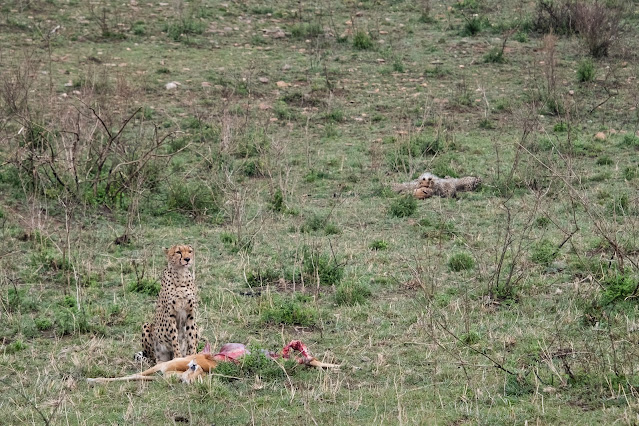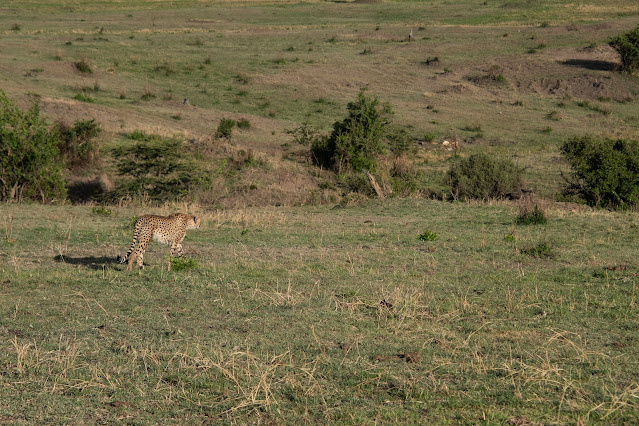Chapter 25:
In Which We Meet SuperMum
Being a mom is a full-time job and being a cheetah mom
is one of the toughest jobs.—YS Wildlife Photography

They had spotted her the evening before, along with her five cubs, searching for game near the border of Kenya and Tanzania. She had been in Tanzania, said the guides, and had just come back to the Maasai Mara. The cubs obviously weren't habituated to the safari vehicles but the more time we spent with them, the more they relaxed into curiosity.
Cheetah cubs are born with a downy underlying fur called a mantle on the back of their necks and shoulders. It disguises them in tall grass, and also gives them the appearance of a honey badger, which frightens away some predators. Nonetheless, cheetahs are endangered.
Their natural habitat is diminishing and lions and hyenas will kill the cubs, and steal food from the adults.
The cheetah and her five were walking toward a valley on the other side of which were numerous grazing animals. Suddenly, the cheetah saw a potential meal for her cubs, and they instantly disappeared into the brush to hide.
There are wildebeest, impala, and zebra in the valley. Only the impala are small enough for the cheetah to take.
She
slowly stalked the animal from the great distance but eventually
decided there was no chance. She returned, called for the cubs, and
they enjoyed some Mum time in the setting sunlight.
Like all cats, including lions and leopards, cheetahs are very affectionate.
These photos indicate an overnight interlude om the SuperMum story.
 |
| Up dark and early at 5:15for the morning game drive |
Our guides quickly find the cheetah Raisi with her five cubs. She is still looking for prey animals.

Raisi took the cubs to an overlook and before we even suspected what was happening, she went down the hill and out of site. The cubs stayed on top.
By the time the guides found a way down the hill, Raisi had finished off an impala. Then, she called for the cubs.
While Raisi rested and then ate a bit of the impala, the cubs gorged themselves.
Suddenly, Raisi noticed more impala on the hill and off she went on a stalk.
I saw only a dust-up at the top of the hill. I heard a commotion from the other two of our vehicles and later learned the guides were astonished at what they had just witnesses. They clapped, they laughed, they high-fived each other.
Never before had any of these experienced guides seen a cheetah take down two animals in little more than a hour and a half. Cheetahs expend a great deal of energy when they chase prey and often need a day to recover.
But soon SuperMum was bringing the animal down the hill to her cubs.
 | |
| Proof of Raisi's astonishing feat. |
 |
| A well-fed cub with a big tummy. |
 |
| Time to relax and then move away from the remains before the hyenas and other predators get there. |
And there you have the story of Raisi, the SuperMum.
 |
| Vultures began gathering shortly after the first kill, waiting their turn to clean up the remains. |
I'm going to end this post with the rest of quote from the beginning of this story. The photographer is talking about a different cheetah than the one above, but it applies to all female cheetahs.
Being a mom is a full-time job and being a cheetah mom is one of the toughest jobs.
Take this cheetah, Imani, for example.
Over a period of 48 hours, we saw her leading her 4 tiny cubs for miles, measuring every step she took as they were surrounded by lions and hyenas.
She had to stop frequently to nurse the cubs.
She had to feed herself and her cubs.
She had to protect them (We saw her chasing a big lioness after she got too close to the cubs).
And she has to play with them...
There's no "Dad" in their life, and she has to do it all by herself.
That’s why we need to help them to make their life a bit easier by not disturbing them and leaving their land untouched.
Here she is scanning the horizon for
a potential meal while one of the cubs is jumping on her and trying to give her
a BIG HUG ![]()




























Great story and fantastic photos.
ReplyDeleteThanks, Bud.
DeleteWe were astounded at the fact Raisi had five cubs, but we don't know what is normal for a Cheetah mother. Interesting Raisi was able to 'call to her cubs' when she wanted them back with her. Interesting also the guides themselves were so pleased with Raisi and the cubs (They clapped, they laughed, they high-fived each other). We enjoyed your tale of Raisi and her cubs. Cap and Patti
ReplyDeleteCheetahs cannot roar. She chirped to call her cubs. I have heard older cubs chirp to call their mother. Cheetahs are fascinating animals. The usual litter is three to five, but some cheetahs have had as many as seven. Unfortunately, only about five percent of cheetah cubs survive to adulthood, with the majority of them perishing in the first six months.
DeleteHow old do you think the cubs are?
ReplyDelete